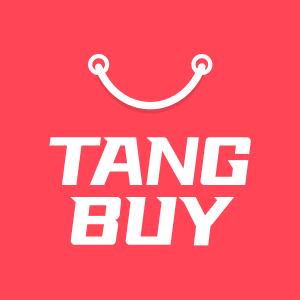6 Top Online Marketplaces to Sell Items Online for Free Dropshopping
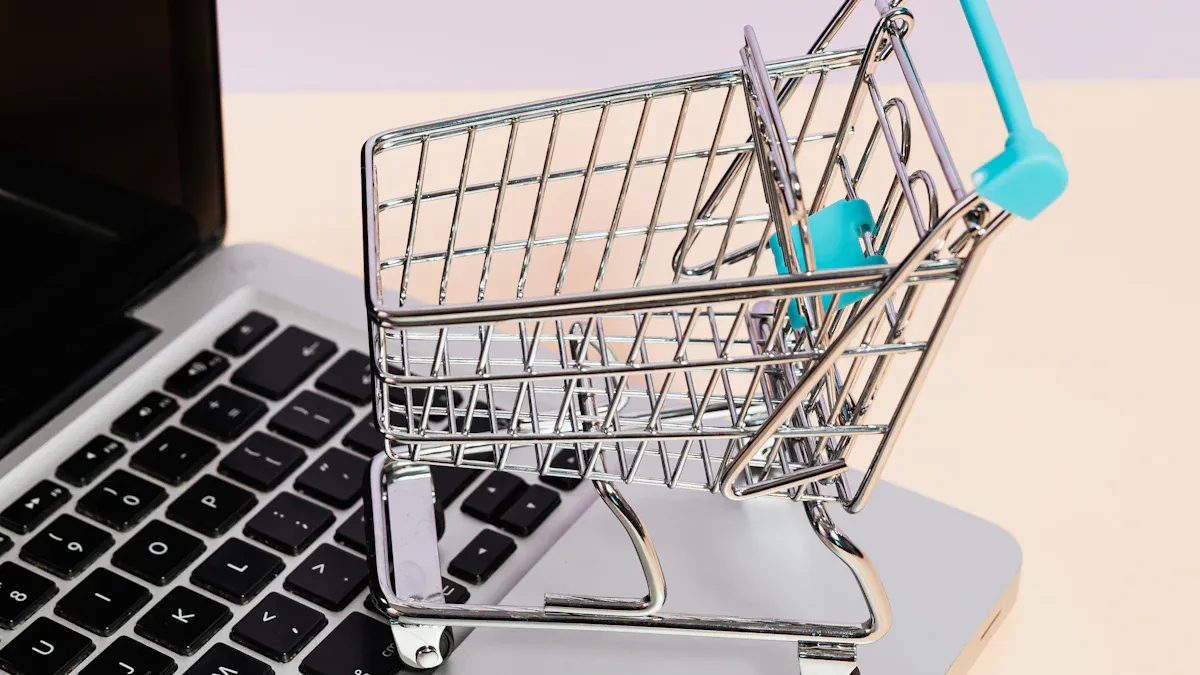
You want to sell your stuff without paying extra fees? Check out these top online marketplaces: Facebook Marketplace, Craigslist, Nextdoor, VarageSale, eCrater, OfferUp, Vinted, and Poshmark. Selling for free means you don’t pay to list or sell your items. Picking the right spot depends on what you’re selling, where you live, and how easy the site feels to use. Did you know online shopping keeps growing every year? Take a look at this chart to see how much people buy and sell online now!
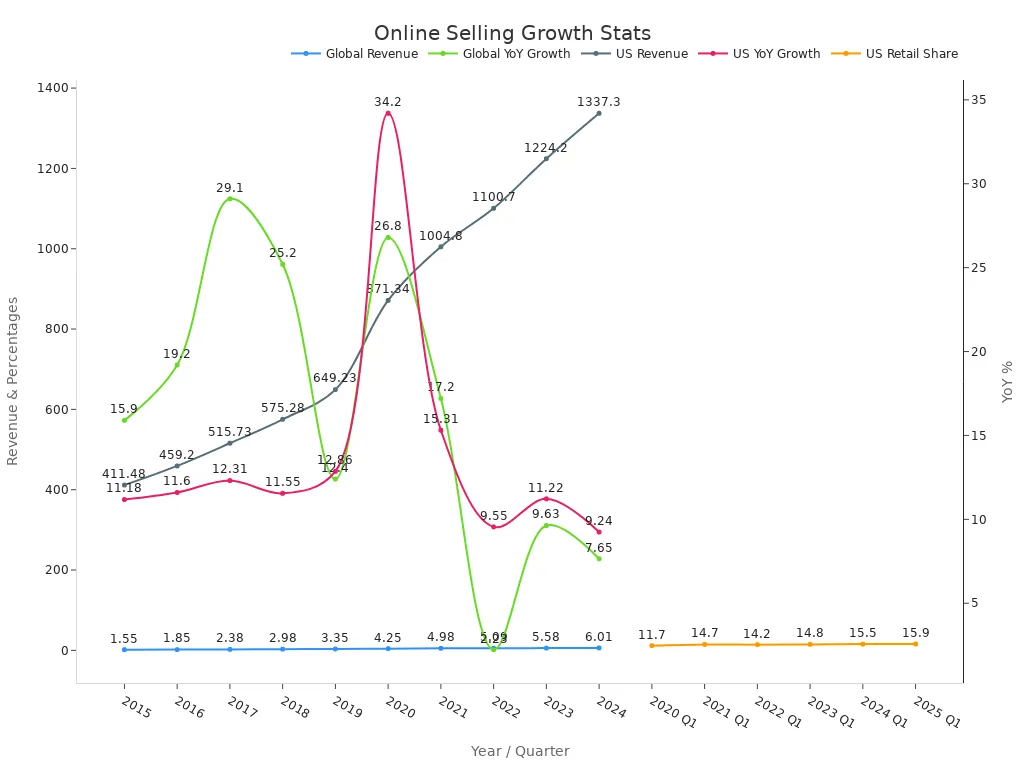
Key Takeaways
Many online marketplaces let you list and sell items for free. This is helpful for local sales. You get to keep all your money.
Pick the right platform for what you want to sell. Think about your location. Make sure the site or app is easy to use.
Some popular free marketplaces are Facebook Marketplace, Craigslist, Nextdoor, VarageSale, OfferUp, eCrater, Vinted, and Poshmark. Each one has special features and different users.
Look out for hidden costs. These can be shipping fees, payment charges, or boosts for your listings. These things can lower your profits.
Safety is important. Always meet buyers in public places. Use in-app messaging. Check user ratings to avoid scams.
Use clear photos and give lots of details in your descriptions. Answer questions quickly. This helps your listings stand out and sell faster.
Choose payment methods that keep you safe. Use cash for local deals. Use secure in-app payments for shipped items.
Selling online is growing fast. There are many chances to turn unused items into cash. Use the right marketplace and smart tips to help you sell.
Selling for Free
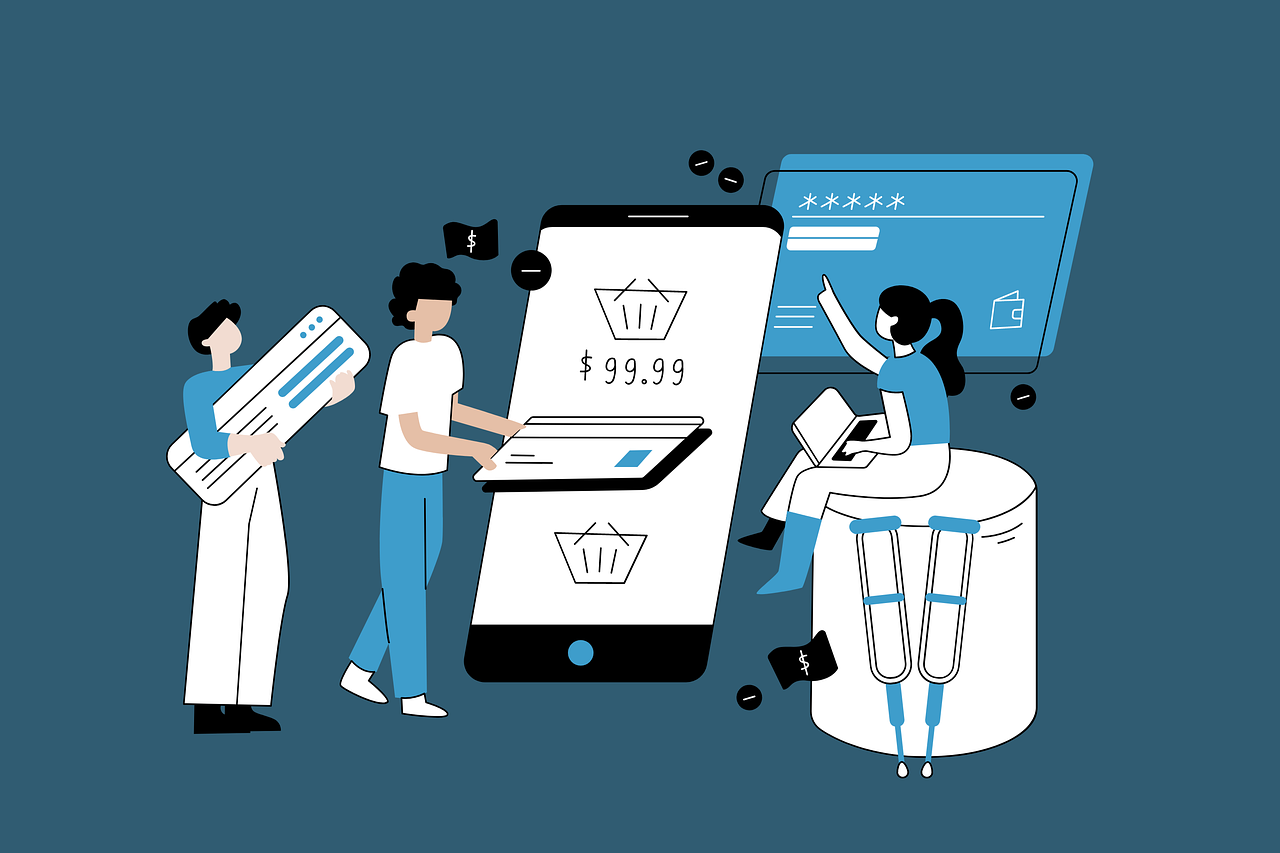
When you want to sell your stuff online, you probably want to keep all the money you make. That’s what “selling for free” means. You don’t pay to list your items, and you don’t lose a cut of your sale to the website. But is it really always free? Let’s break it down.
No Listing Fees
Many top online marketplaces let you post your items for sale without charging you a listing fee. This means you can put up as many items as you want without paying a cent upfront. Here’s a quick look at how some popular platforms handle listing fees:
Platform | Listing Fee Policy | Additional Details |
|---|---|---|
Facebook Marketplace | Free to list items | Only need a Facebook account |
Craigslist | Free local listings | Sellers arrange transactions directly |
OfferUp | Free local listings | No fees for local sales |
Walmart | Completely free to list | |
TikTok Shop | No listing fees | Completely free to list |
Free up to 250 items/month for free accounts | Charges insertion fee beyond free limit |
You can see that most platforms let you list items for free, especially if you’re selling locally. Some sites, like eBay, give you a certain number of free listings each month before they start charging small fees.
No Selling Fees
Selling fees are another thing to watch out for. These are charges that some websites take from your sale price when your item sells. Luckily, many free marketplaces skip these fees, especially for local deals. Here’s a table showing how some platforms handle selling fees:
Platform | Fee Structure Description |
|---|---|
Facebook Marketplace | No listing or commission fees; payment and delivery arranged directly between buyer and seller. |
Craigslist | No selling fees for local listings; sellers handle payment themselves. |
OfferUp | No fees for local sales; buyers and sellers negotiate payment directly. |
Letgo | No fees; direct buyer-seller communication for payment and delivery. |
Ebid | No listing fees; lower seller fees compared to other marketplaces; supports direct sales and auctions. |
You get to keep all your money when you sell on these platforms, as long as you handle payment and delivery yourself.
Hidden Costs
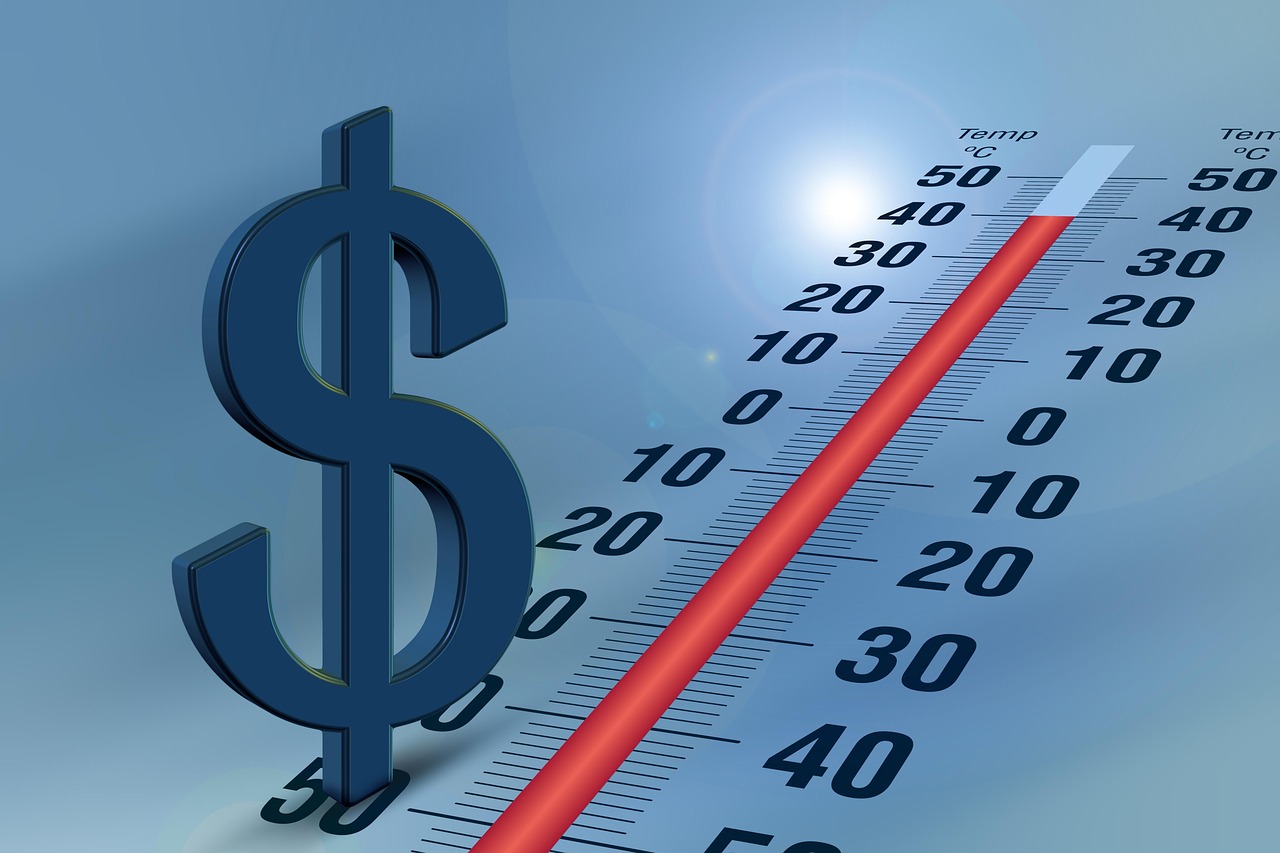
Even if a site says it’s free, you might still run into some extra costs. These can sneak up on you if you’re not careful. For example, if you ship an item to a buyer, you might have to pay for shipping or packaging. Some platforms offer premium features, like boosting your listing so more people see it, but these extras usually cost money.
Payment processing can also add fees. If you use electronic payments, you might pay a small percentage of your sale. Studies show that families sometimes pay up to $0.60 in fees for every $1 spent on electronic payments, especially when using certain payment processors. These fees can add up over time, especially if you sell a lot of items.
Tip: Always check for extra costs before you finish your sale. Look for details about shipping, payment methods, and any premium features the site offers.
So, while many platforms let you sell for free, it’s smart to watch out for hidden costs. This way, you keep more of your hard-earned cash!
Best Online Marketplaces
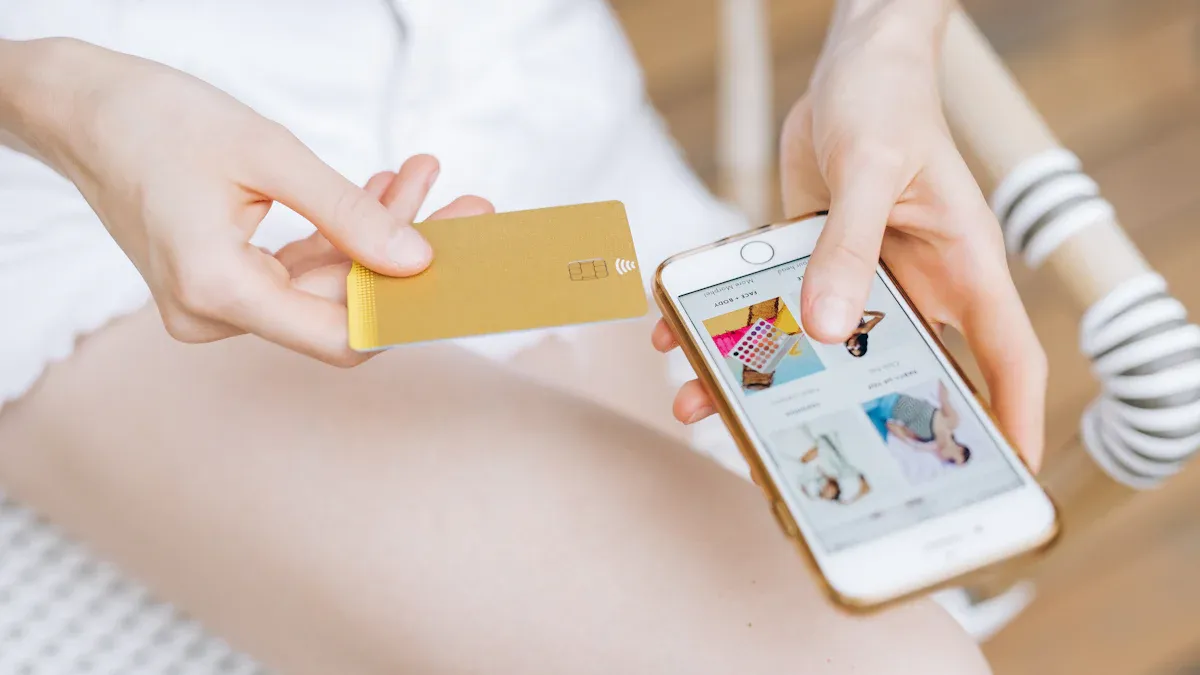
Facebook Marketplace
Overview
Facebook Marketplace lets you sell things to people near you. You just need a Facebook account to start. The site has a huge number of users. Over 3 billion people use it every month. You can talk to buyers using Messenger. This makes chatting quick and simple. Many sellers like that listing items is free. Businesses can also link their Facebook Shops to Marketplace. This helps them get more sales.
Facebook Marketplace is special because it uses trust systems. Buyers and sellers can look at each other's profiles and ratings. This helps you feel safer when selling to strangers.
What to Sell
You can sell many things on Facebook Marketplace. Some popular things are:
Furniture
Electronics
Clothing and shoes
Home goods
Cars and trucks
Toys and games
Some people even sell services or rentals. If you want lots of buyers fast, this is a good place.
Pros
Listing items is free
Huge group of buyers, local and national
Easy to message buyers with Messenger
Simple categories and search tools
You can pay to boost your listing for more views
Businesses can link Facebook Shops for more people to see
Cons
There is a lot of competition in some places
Some people may message but not want to buy
Scams can happen, so you need to be careful
Facebook sometimes removes posts that break the rules
Hidden Costs
Most sales are free if you meet buyers and get paid in person. If you use Facebook’s shipping and checkout, there is a 5% fee per shipment or at least $0.40. Paying to boost your listing or using ads costs extra. Always check for fees before you finish your sale.
Facebook Marketplace is good for free selling. It gives you a big audience and easy tools. Trust systems like profiles and reviews help you feel safe.
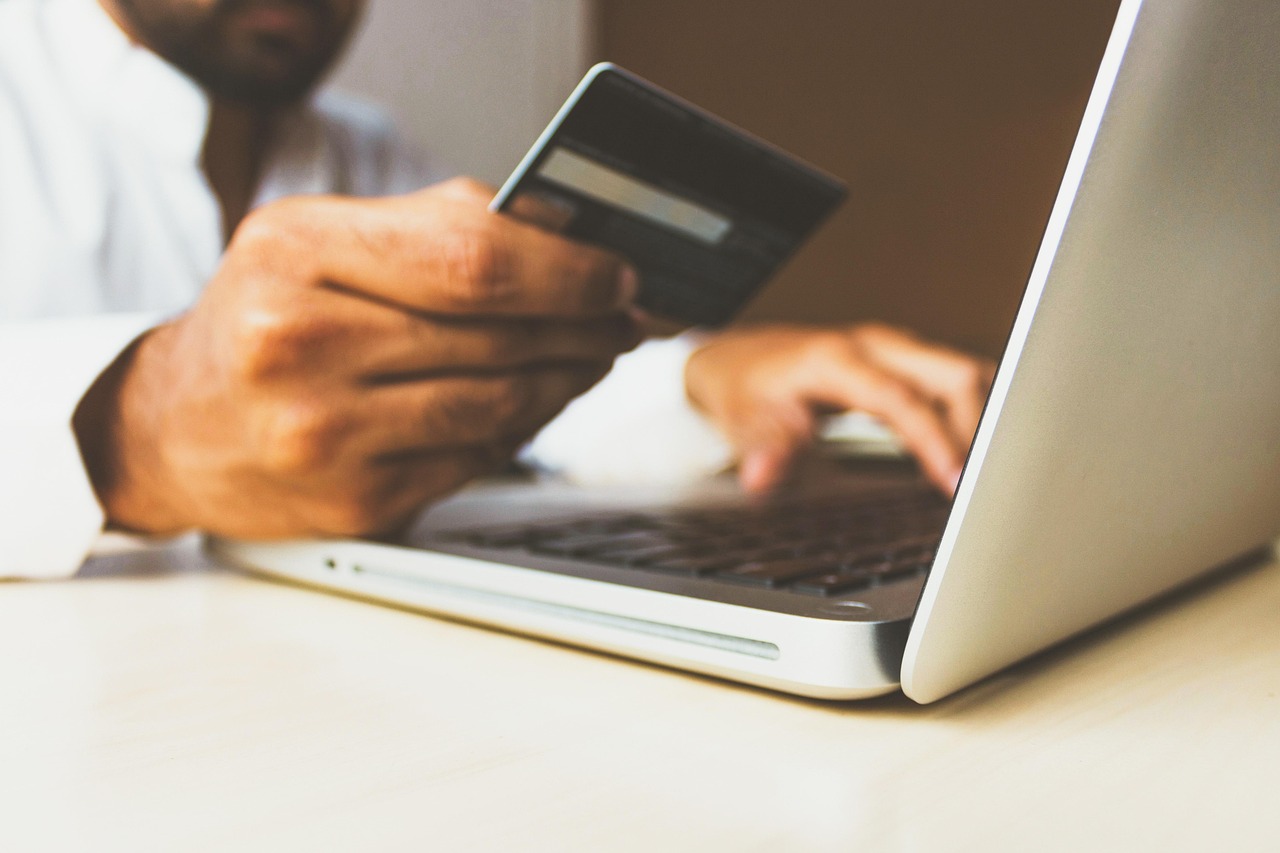
Craigslist
Overview
Craigslist is one of the oldest online marketplaces. It started in 1995 and is still popular for local buying and selling. You can post most things for free. You do not need an account. Craigslist has a simple website. Pick your city, write a description, and add photos.
A big study showed Craigslist helped local business grow. This was true in low-income and immigrant areas. Craigslist is powerful for free selling and helping communities.
What to Sell
Craigslist is best for:
Used furniture
Appliances
Cars and trucks
Tools and equipment
Tickets
Bicycles
Local services
You can also post about housing, jobs, and events. If you want to sell big or heavy things, Craigslist is a good choice.
Pros
No selling fees for local deals
Simple and fast to use
Big local audience in many cities
No account needed for most posts
Cons
The website looks old and can be hard to search
No built-in payment or shipping options
Scams and spam can happen, so be careful
No ratings or reviews for buyers or sellers
Hidden Costs
Most categories are free, but some job posts and services cost money in some cities. You handle payment and delivery yourself, so there are no selling fees. If you ship items, you pay for shipping. Always meet in safe, public places.
Craigslist is a favorite for local selling because it is free and simple. Many people use it to reach buyers in their area without spending money.

Nextdoor
Overview
Nextdoor is a site for people in the same neighborhood. Over 1 in 3 U.S. homes use Nextdoor. It covers more than 285,000 neighborhoods in 11 countries. You can join for free and start selling right away. Nextdoor builds trust by checking users’ addresses. It encourages friendly, local chats.
Statistic Description | Value/Metric |
|---|---|
U.S. Household Reach | Over 1 in 3 households |
Active User Base | Over 29 million users |
Average Monthly Engagement | 52 minutes per member |
Neighborhoods Covered | Over 285,000 neighborhoods |
Countries with Nextdoor Presence | 11 countries |
Local Business Revenue Contribution | 30% of Nextdoor's revenue |
Member Sentiment | Over 85% feel more connected locally |
Global Neighborhood Social Network Market Valuation (Projected) | USD 6 Billion by 2025 |
What to Sell
Nextdoor is great for:
Household items
Kids’ toys and clothes
Garden tools and plants
Local services like babysitting or lawn care
Lost and found items
You can also give away free stuff or ask neighbors for advice.
Pros
Free to list and sell items
Trusted, local community
Easy to connect with real neighbors
Good for selling big or hard-to-ship things
Less competition than bigger sites
Cons
Smaller audience than Facebook or Craigslist
Only people nearby can see your posts
Some neighborhoods have less activity
No built-in payment or shipping options
Hidden Costs
You do not pay fees to list or sell. If you want to boost your post or use business tools, there may be charges. You handle payment and delivery, so watch out for costs when meeting or moving items.
Nextdoor helps you sell to people you know—your neighbors. Its focus on local and verified users makes it a safe place for selling in your community.
VarageSale
Overview
VarageSale is a place where you can sell things to people who live near you. You join groups for your city or neighborhood. Everyone in the group has to prove who they are. This helps make VarageSale feel safe and nice. You can use the website or app to put your items up for sale. It does not cost anything for buyers or sellers to use VarageSale.
What to Sell
You can sell almost anything on VarageSale. It works best for things like:
Clothing and shoes
Baby gear and toys
Home decor and furniture
Books and electronics
Sports equipment
People like to use VarageSale for family items and things they want to sell fast to neighbors.
Pros
You can list and sell items for free
Local groups help you find buyers close by
Checking who people are makes it safer
The app and website are easy to use
The community is friendly
Cons
Not as many people use it as bigger Online Marketplaces
You have to join a local group before selling
Some places have fewer people using it
There are no payment or shipping tools built in
Hidden Costs
You do not pay fees to list or sell on VarageSale. If you meet a buyer, you might pay for gas or parking. You handle all payments yourself, so VarageSale does not charge payment fees. Always meet buyers in a safe, public spot.
Tip: Look at your group’s rules before you post. Some groups have special rules about what you can sell.

OfferUp
Overview
OfferUp is a popular app for selling things to people nearby. You can post your items for free and talk to buyers in your area. The app is simple and lets you list things quickly. OfferUp tries to make buying and selling safe and easy. You can chat with buyers in the app and see their ratings. You can meet in person or ship items if you want more buyers.
OfferUp is made to help you find things or sell things you do not need.
The app uses safe messaging, ratings, and checks to help you feel safe.
You can buy and sell from home, and local deals let you trade items fast.
OfferUp works with shipping and payment partners, so you have more ways to sell.
Reviews and ratings help buyers and sellers trust each other.
You can sell for free on OfferUp. You only pay if you use extra things like promoted listings or shipping.
What to Sell
OfferUp is good for selling:
Electronics and gadgets
Furniture and home goods
Cars and auto parts
Tools and garden equipment
Clothing and shoes
Collectibles and toys
You can sell almost anything, from small things to big things like cars.
Pros
Free to list and sell to people nearby
The app and website are easy to use
Safe messaging and user ratings
Checks help make deals safer
You can ship items to reach more buyers
Many people use OfferUp
Cons
Some places have more buyers than others
Shipping and promoted listings cost extra money
Some people may message but not buy
Scams can happen, so you need to be careful
Hidden Costs
Selling to local buyers is free. If you ship an item, OfferUp takes a small fee. Promoted listings also cost extra. You handle payment for local deals, so there are no payment fees unless you use the app’s payment system.
Note: Always check the details before you ship or promote your listing. Most people sell for free, but extras can cost more.
eCrater
Overview
eCrater is an online marketplace where you can make your own free store. You can list as many items as you want and do not pay any fees. The platform started in 2004 in Irvine, California. eCrater has millions of products and lets you bring in items from eBay. Your products can also show up on Google Shopping, so more people can find your store.
Metric/Feature | Details/Value |
|---|---|
Annual Revenue (2025) | |
Number of Employees | 11 |
Founded | 2004 |
Location | Irvine, California |
Product Range | Millions of products available |
Seller Features | Free online store creation, easy eBay import |
Marketing Integration | Eligible products submitted to Google Shopping |
Marketplace Positioning | Low-risk, low-cost complementary option |
What to Sell
You can sell almost anything on eCrater, like:
Collectibles and antiques
Clothing and accessories
Electronics and gadgets
Home and garden items
Books, movies, and music
eCrater is good for people who want to make their own store and get more buyers.
Pros
Free to make a store and list as many items as you want
Easy to bring in items from eBay
Products can show up on Google Shopping
No monthly or listing fees
Good for reaching more buyers outside other Online Marketplaces
eCrater is a good choice if you want to try selling online without much risk or if you want to use more than one platform.
Cons
Not as many people use it as bigger sites
You need to tell people about your store to get more buyers
No payment tools built in; you set up your own way to get paid
The website looks simple
You will need to work on SEO and marketing to get more people to visit your store.
Hidden Costs
eCrater does not charge for listing or monthly fees. If you sell something through the eCrater marketplace, there is an optional 2.9% fee. You pay for payment processing if you use PayPal or Stripe. You might also spend money on ads to get more people to your store.
Tip: Use eCrater along with other platforms. This helps you find more buyers without extra risk.

Vinted
Overview
Vinted is a popular place where you can sell clothes, shoes, and accessories online without paying any fees. You can join for free and start listing your items right away. Vinted has grown fast and now has over 100 million users. The platform makes selling easy and safe, so you can feel confident when you use it.
You keep 100% of your asking price because Vinted charges no listing fees or commission.
Vinted uses a buyer protection system. The buyer’s money stays in a safe account until they get the item. If there’s a problem, you have 48 hours to report it, and Vinted’s support team will help.
You can talk to buyers through messages and see their ratings. This helps you know who you’re dealing with.
Vinted gives you shipping labels and works with shipping partners. You don’t have to worry about figuring out how to send your items.
The platform is growing in many countries and is popular with people who care about the environment.
What to Sell
Vinted is best for:
Secondhand clothes for men, women, and kids
Shoes and sneakers
Bags and accessories
Jewelry and watches
Some beauty products (check the rules)
Vintage and designer items
If you want to clean out your closet or sell trendy fashion, Vinted is a great choice.
Pros
No fees to list or sell your items
You keep all the money from your sales
Safe payment system protects both buyers and sellers
Easy-to-use app and website
Large, active community with millions of users
Pre-made shipping labels make mailing items simple
Good for eco-friendly and budget shoppers
Cons
You can only sell certain types of items (mostly fashion and accessories)
You must handle shipping for most sales
Some buyers may ask for lower prices
You need to follow Vinted’s rules or your listings may be removed
Hidden Costs
You don’t pay to list or sell, but you might pay for shipping supplies like boxes or tape. Buyers pay a small fee for protection, not sellers. If you want to boost your listings to get more views, that costs extra, but it’s optional.
Tip: Always check Vinted’s rules before listing. This helps you avoid problems and keeps your account in good standing.

Poshmark
Overview
Poshmark is one of the biggest Online Marketplaces for selling fashion, shoes, and home goods. You can use the app or website to list your items and connect with buyers across the US and Canada. Poshmark feels like a social network, where you can share, like, and comment on listings. The platform has over 180 million registered users and gets high ratings on both the Apple App Store and Google Play Store.
Poshmark has a huge community. You can find buyers for almost any style or brand.
The app is easy to use, and you can list items in just a few minutes.
You can join virtual parties to show off your items and meet new buyers.
Poshmark’s social features help you build a following and sell more.
Here’s a quick look at Poshmark’s popularity:
Over 180 million registered users in the US and Canada
4.8 out of 5 stars on the Apple App Store (909,000+ ratings)
4.6 out of 5 stars on Google Play (181,000+ reviews, 10 million+ downloads)
Metric | Value | Description |
|---|---|---|
Active Users (North America, Sept 2020) | Total active users on Poshmark's platform | |
Active Buyers (Sept 2020) | 6.2 million | Buyers actively purchasing on the platform |
Active Sellers (Sept 2020) | 4.5 million | Sellers actively listing and selling items |
Active Buyers (Q4 2020) | 6.5 million | 20% year-over-year increase from 5.4 million in Q4 2019 |
Social Interactions (2020) | 30.4 billion | 48% growth in social engagement on the platform |
International GMV (2019) | $6.4 million | Gross merchandise value from international sales |
International GMV (9 months ended Sept 2020) | $32.6 million | Significant growth in international sales |
User Daily Engagement (2020) | 27 minutes | Average daily time spent by users on the app |
User Base in Canada (within 1 year of launch) | 1.4 million | Growth after expansion to Canada |
Company Valuation (2011 launch) | $600 million+ | Initial valuation reflecting market potential |
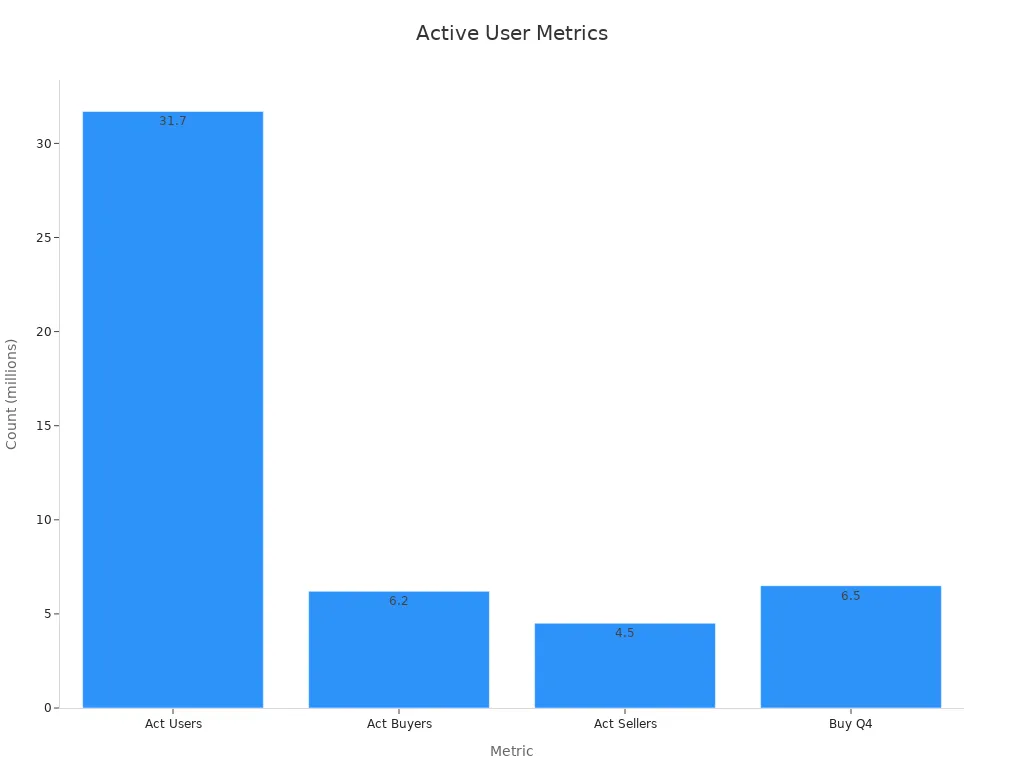
What to Sell
You can sell many things on Poshmark, including:
Women’s, men’s, and kids’ clothing
Shoes, bags, and accessories
Jewelry and watches
Home decor and small home goods
Beauty products (new only)
Designer and luxury brands
If you love fashion or want to sell home items, Poshmark is a top pick.
Pros
Huge, active community of buyers and sellers
Easy to list items with your phone
Social features help you get more attention for your listings
Prepaid shipping labels make mailing items simple
You can join themed parties to boost your sales
High user ratings show people trust and enjoy the platform
Cons
Poshmark takes a fee from each sale (20% for sales over $15, $2.95 for sales under $15)
You must ship items to buyers, which takes time
Some buyers may offer low prices
You need to be active to get the most out of the platform
Hidden Costs
You pay a selling fee when your item sells. Poshmark takes 20% of the sale price for items over $15, or $2.95 for items under $15. You might also spend money on packaging supplies. Listing is free, and you only pay when you make a sale.
Note: Poshmark’s fees are higher than some other Online Marketplaces, but the large audience and easy shipping can help you sell faster.
Comparing Online Marketplaces
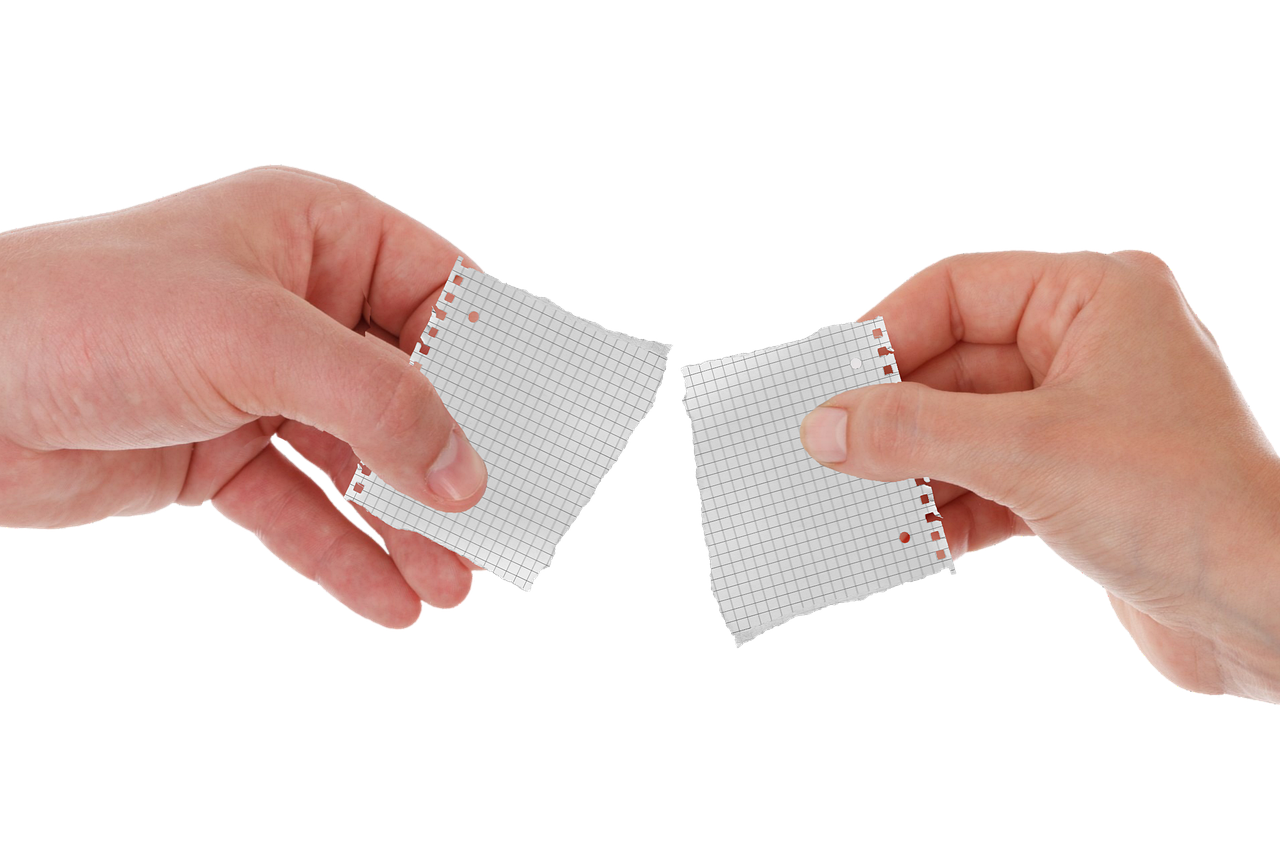
Comparison Table
It is easier to choose where to sell if you compare them. The table below shows the top free Online Marketplaces side by side. You can see the fees, what you can sell, and who will see your items.
Marketplace | Listing Fees | Selling Fees | Best For | Audience Size/Reach | Pros | Cons |
|---|---|---|---|---|---|---|
Facebook Marketplace | None | None (local) | Almost anything, local sales | Huge, local & national | Big audience, easy to use | High competition, scams |
Craigslist | None | None (local) | Furniture, big items, services | Large, local | Simple, no fees | No reviews, scams possible |
Nextdoor | None | None | Household, kids’ stuff, services | Local neighborhoods | Trusted, local-only | Smaller audience |
VarageSale | None | None | Family items, quick local sales | Local groups | Safe, verified users | Fewer users, local only |
OfferUp | None | None (local) | Electronics, cars, home goods | Large, mostly local | Easy app, ratings | Shipping costs extra |
eCrater | None | Optional 2.9% | Collectibles, custom stores | Smaller, global | Free store, Google Shopping | Lower traffic |
Vinted | None | None | Fashion, shoes, accessories | Large, fashion-focused | No fees, safe payments | Fashion only, shipping |
Poshmark | None | 20%/$2.95 | Fashion, home goods | Huge, social community | Big audience, easy shipping | High fees, fashion focus |
This table helps you see the main features and costs. You can quickly find which platform matches what you need.
Fees and Costs
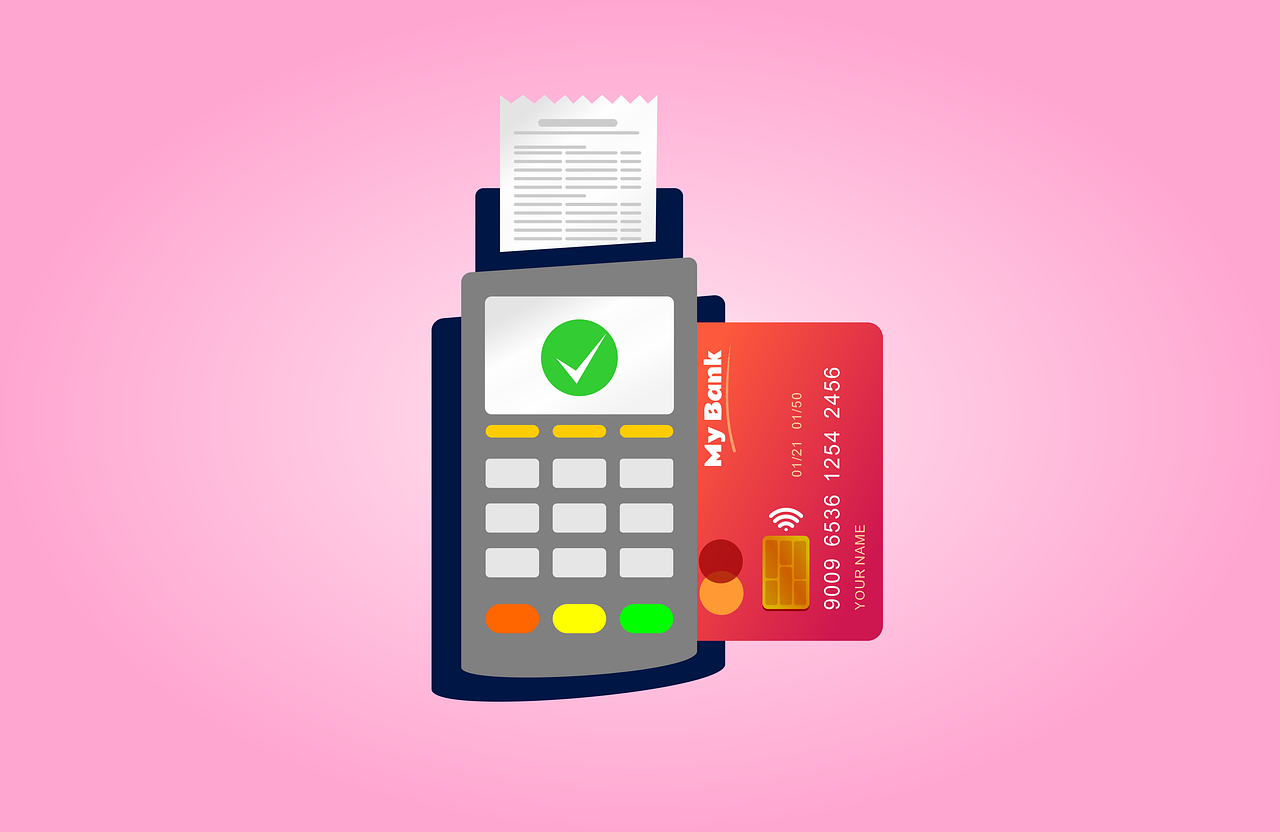
Most people want to keep all the money they make when selling. Many free Online Marketplaces let you list and sell without paying fees, especially for local deals. Some sites charge for extra things or special sales.
No Listing Fees: You can list for free on Facebook Marketplace, Craigslist, Nextdoor, VarageSale, OfferUp, eCrater, and Vinted.
Selling Fees: Most places do not charge for local sales. Poshmark takes 20% from sales over $15, or $2.95 for sales under $15. eCrater has an optional 2.9% fee if you sell through their marketplace.
Hidden Costs: Sometimes you pay for shipping, payment fees, or boosting your listing. For example, shipping with OfferUp or Vinted may mean buying boxes or paying for postage.
Tip: Always read the details before you sell. Some sites add small fees for shipping or special features.
Item Types

Not every marketplace is good for every kind of item. Some are best for fashion, while others are better for furniture or electronics. Use this guide to match your items to the right place:
Facebook Marketplace: Good for almost anything like furniture, electronics, clothes, and cars.
Craigslist: Best for big things like furniture, tools, and cars. Also good for services and jobs.
Nextdoor: Great for household goods, kids’ items, and local services.
VarageSale: Works well for family items, toys, and things you want to sell fast to neighbors.
OfferUp: Good for electronics, home goods, and cars. You can sell almost anything.
eCrater: Lets you set up a store for collectibles, antiques, and many other products.
Vinted: Focuses on fashion—clothes, shoes, and accessories.
Poshmark: Best for fashion, shoes, accessories, and some home goods.
If you want to sell something different, check the rules first. Some sites only let you sell certain things.
Each marketplace has its own strengths. Think about what you want to sell and who you want to reach. This will help you choose the best place to sell your items fast.
Audience and Reach
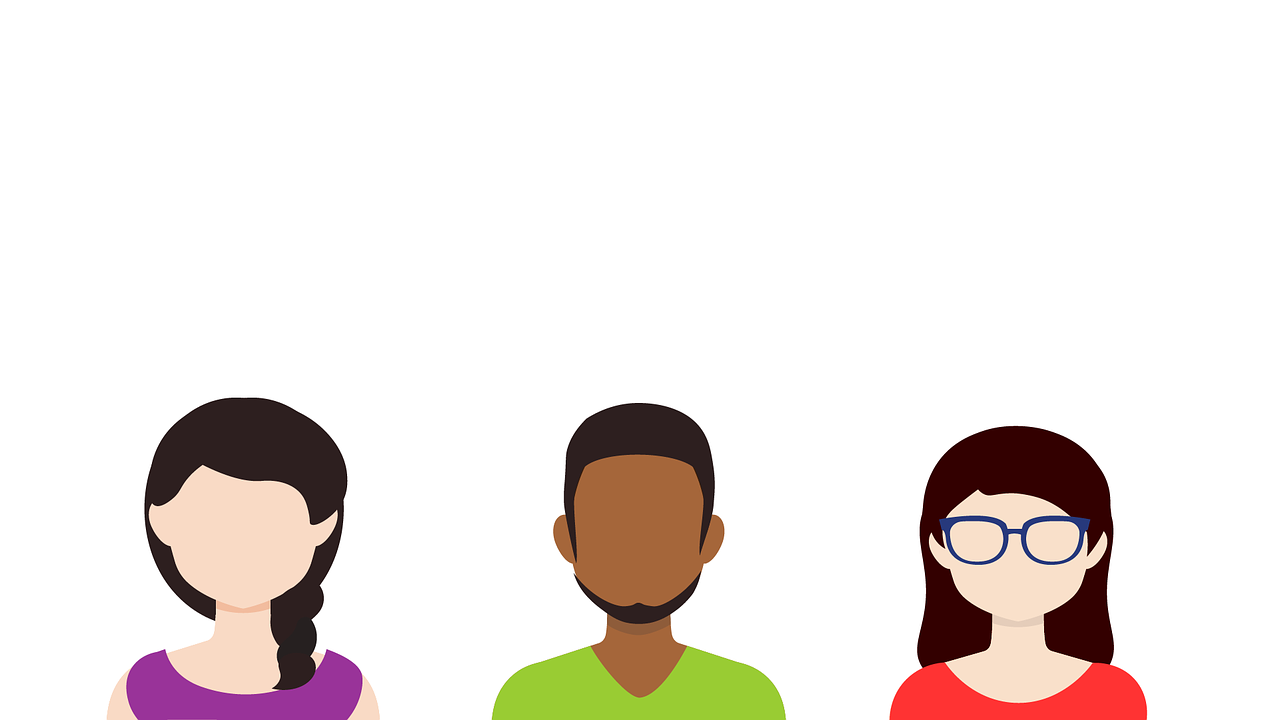
When you pick a place to sell your stuff, you want to know who will see your listings. Each marketplace has a different audience and reach. Some sites have millions of users. Others focus on smaller, local groups. Let’s look at how each one connects you with buyers.
Facebook Marketplace
You reach a huge crowd here. Almost everyone with a Facebook account can see your items. You can sell to people in your city or even ship to buyers across the country. If you want lots of eyes on your stuff, this is a great choice.
Craigslist
Craigslist works best for local sales. People in your area check the site for deals. You won’t reach buyers far away, but you can connect with folks nearby who want to pick up items fast.
Nextdoor
Nextdoor keeps things close to home. Only people in your neighborhood or nearby areas see your posts. This makes it easy to sell to people you might already know or see around town.
VarageSale
VarageSale uses local groups. You join a group for your city or neighborhood. Your listings show up for people in that group. This helps you find buyers who live close by and want to meet in person.
OfferUp
OfferUp has a big user base, especially in larger cities. You can sell to people nearby or ship items to buyers in other places. The app shows your listings to users in your area first, so local deals happen fast.
eCrater
eCrater lets you reach buyers all over the world. You set up your own store, and anyone can find it online. You might not get as many visitors as bigger sites, but you can still reach people outside your town.
Vinted
Vinted is popular with people who love fashion. The app has millions of users, mostly looking for clothes and accessories. You can sell to buyers across the country, not just in your city.
Poshmark
Poshmark has a huge, active community. People from all over the US and Canada shop here. If you want to reach fashion lovers and home decor fans, this is a top pick.
Tip: Think about who you want to reach. If you want to sell fast, pick a site with lots of local users. If you want to reach more people, try a bigger platform or one that lets you ship.
Online Marketplaces give you different ways to connect with buyers. Some focus on your neighborhood. Others help you reach shoppers across the country or even the world. Choose the one that matches your goals and the items you want to sell.
Choosing the Right Marketplace
Item Type
What you want to sell matters a lot. Some platforms work better for certain items. If you have clothes or shoes, Vinted and Poshmark are great picks. They focus on fashion and have buyers looking for those things. For furniture or big items, Facebook Marketplace and Craigslist are strong choices. You can find local buyers who want to pick up heavy stuff.
If you have collectibles or want to set up your own store, eCrater gives you more freedom. OfferUp is good for electronics, tools, and even cars. Nextdoor and VarageSale work well for family items, toys, and things you want to sell quickly to neighbors.
Tip: Always check the rules of each site. Some places only allow certain types of items.
Local vs. National
Think about where you want your buyers to come from. If you want to sell to people nearby, choose a local platform. Facebook Marketplace, Craigslist, Nextdoor, and VarageSale help you connect with buyers in your area. You can meet up, skip shipping, and get paid in person.
If you want to reach more people, try a national or even global platform. Poshmark, Vinted, OfferUp (with shipping), and eCrater let you sell across the country. You might sell faster, but you will need to handle shipping and tracking. Some buyers like to shop local, while others want rare or special items from far away.
Here’s a quick table to help you decide:
Platform | Local Sales | National/Shipping |
|---|---|---|
Facebook Marketplace | ✅ | ✅ |
Craigslist | ✅ | ❌ |
Nextdoor | ✅ | ❌ |
VarageSale | ✅ | ❌ |
OfferUp | ✅ | ✅ |
eCrater | ❌ | ✅ |
Vinted | ❌ | ✅ |
Poshmark | ❌ | ✅ |
User Experience
You want selling to feel easy and smooth. Some sites have simple apps and clear steps. Others might feel old or confusing. If you like quick listings and easy chats, Facebook Marketplace and OfferUp are user-friendly. Poshmark and Vinted also have clean apps with lots of helpful features.
Payment options matter, too. Many people stop buying if they cannot use their favorite way to pay. In fact, about 11% of users leave their cart if their preferred payment method is missing. Some sites only let you use cash or one payment app. Others offer more choices, like PayPal, credit cards, or in-app payments. When you see a payment button that matches your choice, you feel more confident.
🛒 Did you know? Over 1 in 5 e-commerce sites lose sales because they do not offer enough payment options. Picking a marketplace with flexible payments can help you sell more and keep buyers happy.
Choose a platform that feels easy for you and your buyers. The right user experience can make selling online much more fun and successful.
Safety
When you sell things online, safety should always come first. You want to protect yourself, your money, and your personal information. Not every marketplace offers the same level of safety, so you need to know what to look for.
Here are some ways to stay safe when selling online:
Meet in public places: Always pick a busy spot, like a coffee shop or a police station parking lot, for in-person exchanges. Many cities have “safe exchange zones” just for this reason.
Bring a friend: If you feel nervous, ask someone to come with you. Two people are safer than one.
Trust your gut: If a buyer seems pushy or something feels off, you can walk away. You do not have to complete the sale.
Keep your info private: Never share your home address, phone number, or bank details unless you trust the buyer and the platform.
Use in-app messaging: Most platforms have their own chat system. Stick to it. This keeps your conversations private and gives you proof if something goes wrong.
Tip: Some platforms, like Facebook Marketplace and OfferUp, show user ratings and profiles. Always check these before meeting someone. A good rating means the person has made safe deals before.
Safety Features by Platform
Marketplace | User Ratings | Verified Profiles | In-App Messaging | Safe Exchange Zones |
|---|---|---|---|---|
Facebook Marketplace | ✅ | ✅ | ✅ | ❌ |
Craigslist | ❌ | ❌ | ❌ | ❌ |
Nextdoor | ✅ | ✅ | ✅ | ❌ |
VarageSale | ✅ | ✅ | ✅ | ❌ |
OfferUp | ✅ | ✅ | ✅ | ✅ |
eCrater | ❌ | ❌ | ❌ | ❌ |
Vinted | ✅ | ✅ | ✅ | ❌ |
Poshmark | ✅ | ✅ | ✅ | ❌ |
You can see that some platforms do more to keep you safe. OfferUp even lists safe exchange zones in the app. Craigslist does not have many safety features, so you need to be extra careful there.
Remember: If a deal sounds too good to be true, it probably is. Scammers often use fake stories or rush you to make a quick sale. Take your time and double-check everything.
Payment Methods
How you get paid matters just as much as where you sell. Some payment methods are safer than others. You want to pick one that protects you and makes the sale easy.
Popular payment methods for online selling:
Cash: Simple and fast for local deals. You hand over the item, and the buyer gives you money. Always count the cash before you finish the deal.
Mobile payment apps: Apps like Venmo, Cash App, or Zelle let you send and receive money quickly. Only use these with people you trust. Once you send money, you cannot get it back.
In-app payments: Some platforms, like Poshmark and Vinted, handle payments for you. The buyer pays the app, and you get the money after you ship the item. This adds a layer of safety.
PayPal: Many sellers like PayPal because it offers buyer and seller protection. If something goes wrong, you can open a dispute.
Note: Never accept checks or money orders from strangers. These can be fake, and you might lose your item and your money.
Payment Options by Platform
Marketplace | Cash | Mobile Apps | In-App Payment | PayPal |
|---|---|---|---|---|
Facebook Marketplace | ✅ | ✅ | ❌ | ✅ |
Craigslist | ✅ | ✅ | ❌ | ✅ |
Nextdoor | ✅ | ✅ | ❌ | ❌ |
VarageSale | ✅ | ✅ | ❌ | ❌ |
OfferUp | ✅ | ✅ | ✅ | ❌ |
eCrater | ❌ | ❌ | ❌ | ✅ |
Vinted | ❌ | ❌ | ✅ | ❌ |
Poshmark | ❌ | ❌ | ✅ | ❌ |
You can see that some platforms give you more choices than others. In-app payments are usually the safest because the platform helps if there is a problem.
Quick Tip: Always check how you will get paid before you list your item. Pick the method that feels safest for you.
By thinking about safety and payment methods, you can sell your items online with confidence. Stay smart, trust your instincts, and enjoy making extra cash!
Tips for Selling
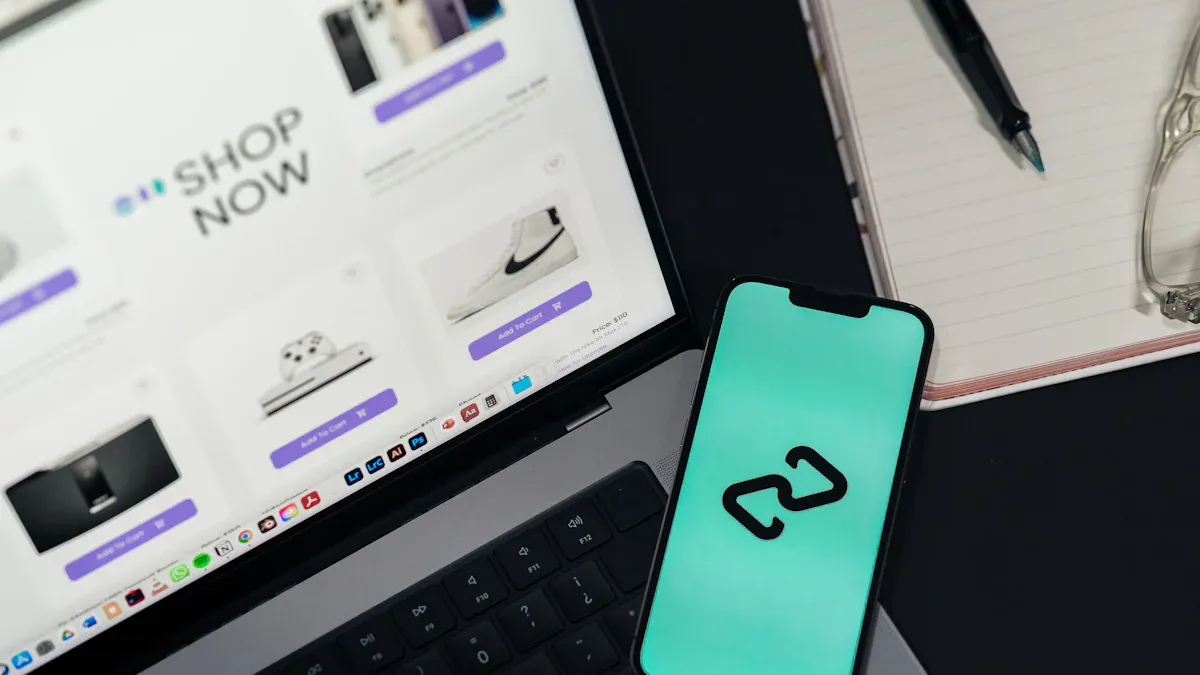
Effective Listings
You want your items to stand out and sell fast. Start with clear, bright photos. Use natural light and show your item from different angles. Write a simple title that tells buyers exactly what you’re selling. For example, “Red Nike Running Shoes, Size 8, Like New” works better than just “Shoes.”
Here are some steps to make your listings more effective:
Set up real-time alerts. Many marketplaces let you set alerts for items you want to buy or sell. This helps you spot deals and trends quickly.
Ask for reviews. After a sale, kindly ask buyers to leave feedback. Good reviews build trust and help your future listings get noticed.
Use platform tools. Some sites offer ways to boost your listing or promote it during busy times. Try these features if you want more eyes on your items.
Keep track of your items. If you sell on more than one site, make sure you update your listings so you don’t sell the same thing twice.
Use the right keywords. Think about what buyers might search for. Add those words to your title and description.
Give great service. Respond quickly to questions and ship items fast. Happy buyers often leave good reviews.
Tip: Tailor your listing to each platform. Some sites like lots of photos, while others focus on keywords. Check what works best where you’re selling.
Communication
Good communication helps you sell faster and keeps buyers happy. Most buyers want to find answers on their own, so make sure your listing has all the important details. If someone messages you, reply as soon as you can. Quick answers show you care and help build trust.
Use the app’s chat or messaging system. This keeps your info private and gives you a record of your conversation.
Be friendly and polite. Even if a buyer asks a lot of questions, stay patient.
If you get the same question often, add the answer to your listing. This saves time for both you and the buyer.
Some platforms let you use live chat or even video messages. These tools help you connect with buyers and answer questions fast.
Share extra photos or details if a buyer asks. This can help them decide to buy.
Buyers love quick, clear answers. The faster you reply, the more likely you are to make a sale.
Safe Meetings
Meeting buyers in person can be safe if you follow a few simple rules. Always pick a public place, like a coffee shop or a busy parking lot. Many police stations have safe exchange zones just for this reason.
Bring a friend if you feel unsure.
Tell someone where you’re going and when you’ll be back.
Meet during the day when it’s light outside.
Count the cash before you hand over your item.
Trust your gut. If something feels off, you can walk away.
Stay safe: Never invite strangers to your home. If a buyer refuses to meet in public, it’s okay to cancel the deal.
Secure Payments
Getting paid safely is just as important as making the sale. You want to make sure you actually get your money and avoid scams. Many buyers and sellers now use secure digital payments because they are fast, easy, and safe. Let’s look at how you can protect yourself and pick the best payment method.
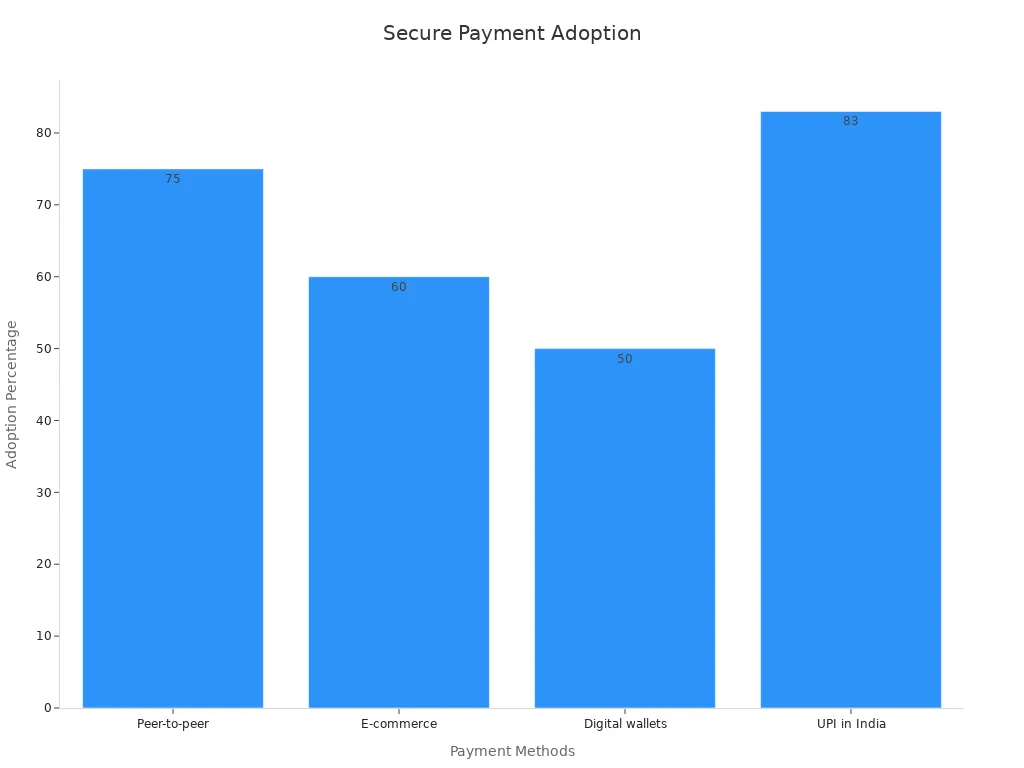
You might notice that more people trust digital payments every year. Peer-to-peer transfers, like Venmo or Zelle, lead the way with a 75% adoption rate. E-commerce payments follow at 60%. Digital wallets, such as Apple Pay or Google Pay, now make up about half of all online shopping payments worldwide. This shift shows that buyers and sellers want safe, simple ways to move money.
The global payment gateway market hit $31 billion in 2023. Experts think it will grow to $161 billion by 2032. In places like Asia-Pacific, cashless transactions are booming. Digital wallets are expected to handle 54% of all e-commerce payments by 2026. These numbers show that secure payments are not just a trend—they are the new normal.
When you sell online, you have a few good options for getting paid:
Payment Method | How Safe? | When to Use It | What to Watch For |
|---|---|---|---|
Cash | 👍 Good for local | In-person, small sales | Counterfeit bills |
Venmo, Zelle, Cash App | 👍 Very safe if you know the buyer | Local sales, trusted buyers | No buyer/seller protection |
PayPal | 👍👍 Safer with protection | Online, shipped items | Fees, only ship to address |
In-app Payments | 👍👍👍 Safest on some platforms | Poshmark, Vinted, OfferUp | Wait for payment release |
Tip: Always double-check that you received the money before handing over your item. If you use PayPal, make sure the payment is marked as “Goods and Services” for extra protection.
Here are some quick tips to keep your payments secure:
Meet in person and use cash for local deals. Count the money before you finish.
Use trusted apps like Venmo or Zelle only with people you know. These apps do not offer refunds if something goes wrong.
For shipped items, use PayPal or the marketplace’s own payment system. These offer buyer and seller protection.
Never accept checks or wire transfers from strangers. Scammers often use these to trick sellers.
Watch out for fake payment emails. Always check your account directly to confirm payment.
🚨 Stay alert: If a buyer wants to pay more than your asking price or asks you to use a strange payment method, it could be a scam.
Digital payments are growing fast. Over 80% of e-commerce deals now use them. Mobile payment users could reach 4.5 billion by 2025. Digital wallets will soon handle more than half of all online payments. Even new tech like biometric and blockchain payments is catching on, making things even safer.
You can sell with confidence when you choose secure payment methods. Stick with what you know, trust your gut, and always check your payment before you hand over your item. Safe payments mean happy selling!
You have many great options when you want to sell your stuff for free. Each platform fits different needs, so think about what you want to sell and who you want to reach. Online Marketplaces keep growing fast, making it easier for you to find buyers. Check out the numbers below to see how big these platforms have become!
Metric/Marketplace | Value/Projection | Year/Period |
|---|---|---|
Total GMV of Top 100 Global Marketplaces | $3.832 trillion | 2024 (projected) |
Market Size Growth | Doubled in 6 years | 2018-2024 |
10.0% | 2024 (projected) | |
GMV Growth Rate | 8.2% | 2023 |
GMV Growth Rate | 2.5% | 2022 |
GMV Growth Rate | 17.7% | 2021 |
GMV Growth Rate | 29.5% | 2020 |
Taobao Third-Party Sales | $723.8 billion | 2023 |
Taobao Projected Sales | $762.0 billion | 2024 |
Tmall Third-Party Sales | $682.7 billion | 2023 |
Tmall Projected Sales | $714.1 billion | 2024 |
JD.com Third-Party Sales | $249.9 billion | 2023 |
Amazon Third-Party Sales | $435.7 billion | 2023 |
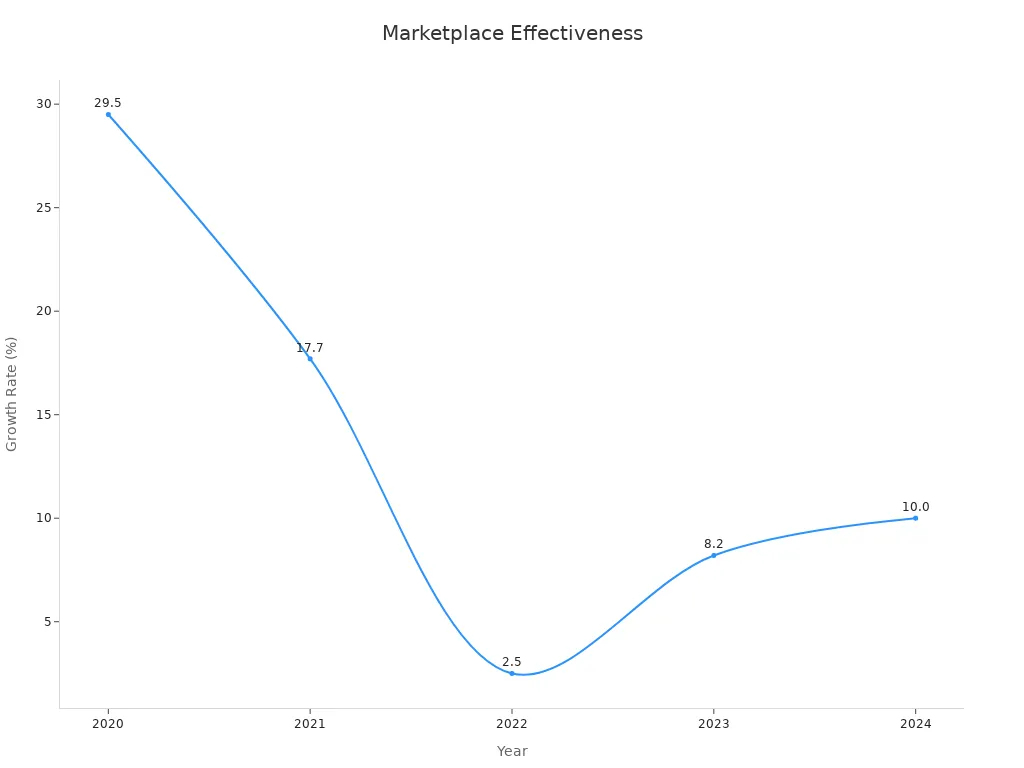
You can start selling online for free today. Pick the marketplace that matches your goals, and enjoy turning your unused items into cash!
FAQ
How do I avoid scams when selling online?
Always meet buyers in public places. Trust your instincts. Use in-app messaging. Never share personal details. If a deal feels off, walk away.
Stay safe: Cash or trusted payment apps work best for local sales.
Can I sell anything on these free marketplaces?
No, each site has its own rules. Most allow common items like clothes, electronics, and furniture. Some ban things like weapons, animals, or recalled products.
Tip: Check the platform’s guidelines before you list your item.
Do I need to pay taxes on what I sell?
If you sell as a hobby, you usually don’t pay taxes. If you sell a lot or run a business, you might owe taxes.
Hobby Seller | Business Seller |
|---|---|
Usually no tax | May owe tax |
What if my item doesn’t sell?
Try better photos or a lower price. Update your description. Share your listing in more groups or on social media.
Relist after a week
Ask friends to share
How do I ship items safely?
Use strong boxes and lots of padding. Always get a tracking number. Share it with your buyer.
Note: Some platforms offer prepaid shipping labels to make things easier.
Can I sell to people in other states or countries?
Yes, some platforms let you ship nationwide or even worldwide. You handle shipping and payment. Local-only sites work best for in-person deals.
What should I do if a buyer wants to negotiate?
Stay polite. Decide your lowest price before you reply. You can accept, counter, or say no.
Remember: You control the sale. Don’t feel pressured.

TangBuy: A Smarter Way to Dropship in 2025
If you're looking to stay competitive with dropshipping in 2025, speed and trend-awareness are key. TangBuy helps you stay ahead with real-time product trends, fast fulfilment, and factory-direct sourcing. With over 1 million ready-to-ship items, 24-hour order processing, and seamless Shopify integration, TangBuy makes it easier to test, scale, and succeed in today's fast-moving eCommerce landscape.
See Also
Choosing Between Amazon And eBay For Sellers In 2025
Deciding On Amazon Or eBay For Your Business 2025
A Beginner’s Guide To Selling Perfumes Online Successfully
